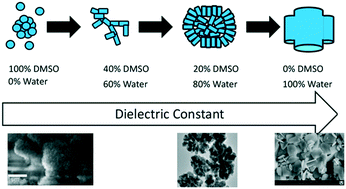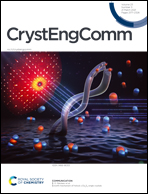Barium sulfate crystallization in non-aqueous solvent†
Abstract
Crystallisation is performed in a non-aqueous solvent, dimethylsulfoxide (DMSO), in order to determine what the role of water is on the crystallisation pathway. In both water and DMSO environments the particles do not appear to grow by ion addition but rather appear to grow through aggregation. The main difference in water is that the aggregation processes are not random and result in particle morphologies that bear relation to the single-crystal faces, suggesting an oriented attachment mechanism. In DMSO, the aggregation processes appear less oriented and while there is some lattice registry, lattice mismatch is also observed and the aggregate shape is spherical overall. This is confirmed in the 1200 cm−1 infrared band shift to 1174 cm−1 suggesting a strained solid is formed. It is observed that the solubility of barium sulfate in DMSO is higher than in water (presumably caused by a strong Ba2+⋯O![[double bond, length as m-dash]](https://www.rsc.org/images/entities/char_e001.gif) S(CH3)2 interaction), which explains the lower nucleation rates in DMSO compared to water at the same concentration. Intriguingly, there is a lower nucleation rate observed (even at a relatively high supersaturation) when Ba2+ is solvated with DMSO supporting the hypothesis that de-solvation of the cation is the rate determining step in nucleation and is of higher activation energy in DMSO than in water.
S(CH3)2 interaction), which explains the lower nucleation rates in DMSO compared to water at the same concentration. Intriguingly, there is a lower nucleation rate observed (even at a relatively high supersaturation) when Ba2+ is solvated with DMSO supporting the hypothesis that de-solvation of the cation is the rate determining step in nucleation and is of higher activation energy in DMSO than in water.

- This article is part of the themed collections: Introducing the CrystEngComm Advisory Board and their research and Crystal Growth


 Please wait while we load your content...
Please wait while we load your content...